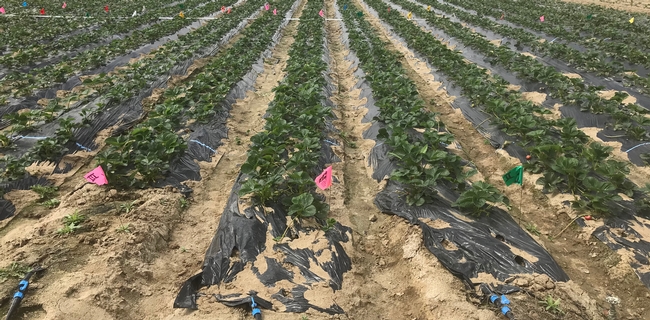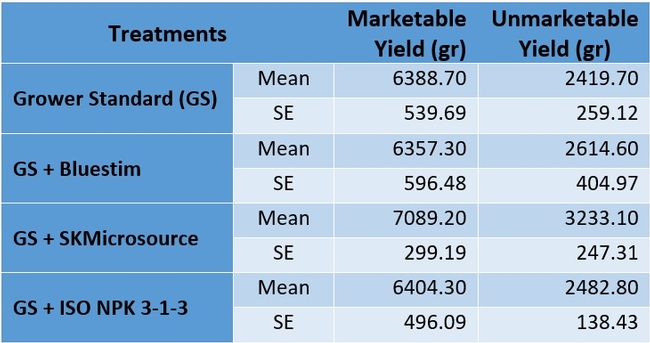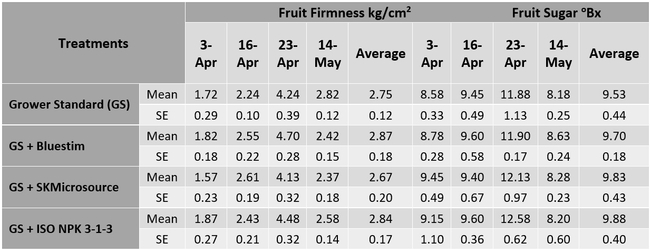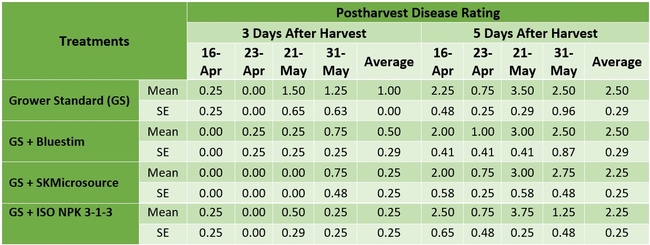Good nutrient management is essential not only for optimal plant growth, but also for maintaining good plant health and the ability of the plant to withstand biotic and abiotic stressors. Strawberry, a $3.2 billion commodity in California, requires good nutrient, water, and health management throughout its lengthy fruit production cycle. In addition to the primary nutrient inputs, certain supplements can be beneficial to the crop. A study was conducted in fall-planted strawberries from 2017 to 2018 using a plant-based anti-stress agent, humates, and sulfur, and a special formulation of NPK as supplements to the standard fertility program to evaluate their impact on strawberry fruit yields and quality.
Methodology
Strawberry cultivar Albion was planted during the second week of December 2017 in 38” wide beds with two rows of plants per bed. This study included the following treatments:
1. Grower standard (GS) program included a total of 6.13 gallons of Urea Ammonium Nitrate Solution 32-0-0, 2.59 gallons of Ammonium Polyphosphate Solution, and 6.95 gallons of Potassium Thiosulfate (KTS 0-0-25) to 0.5 acres of the strawberry field. These fertilizers were applied between 5 January and 18 May 2018 approximately at weekly intervals through the drip irrigation system. Additionally, 1 quart of Nature's Source Organic Plant Food 3-1-1 was applied on 5 and 22 January 2018 and again on 5 February 2018.
2. GS + Bluestim at 3.6 lb/ac in 53 gallons applied as a foliar spray with 0.125% Dyne-Amic once every three weeks for a total of six times. Bluestim is an osmoregulator containing >96% of glycine betaine that is expected to protect plants from abiotic stressors.
3. GS + SKMicrosource Ultrafine powder at 1.4 oz in 4 gallons applied as a foliar spray once a month for a total of three times along with SKMicrosource prill applied at 500 lb/ac at the base of the plant once. Both products contain elemental sulfur, sulfite, and sulfate along with potassium, micronutrients, and rare earth minerals. Additionally, the prill form also has humates. These products are expected to improve plants' natural defenses against biotic stressors like pests and diseases.
4. GS + ISO NPK 3-1-3 at 8 fl oz/ac in 100 gallons once every two weeks for a total of four times. ISO NPK 3-1-3 contains isoprenoid amino complex extracted from a desert shrub guayule (Pathenium argentatum), which is expected to improve nutrient uptake and protect plants from abiotic stressors.
The first application of supplements for treatments 2-4 started on 1 March 2018. Each treatment had a 30' long plot marked on a bed replicated four times in a randomized complete block design. The fruit was harvested one to two times per week between 3 April and 14 June 2018 and the weight of marketable and unmarketable berries was determined for each plot. Using a penetrometer, fruit firmness was measured from four fruits from each plot on 3, 16, and 23 April and 14 May 2018. Sugar content was also measured from two fruits from each plot on those four sampling dates. Postharvest health was measured from the fruit harvested on 16 and 23 April and 21 and 31 May 2018. Fruit was kept in perforated plastic containers (clamshells) at room temperature and the growth of gray mold (Botrytis cinerea) and Rhizopus fruit rot (Rhizopus spp.) was rated 3 and 5 days after harvest on a scale of 0 to 4 (where 0=no disease, 1=1-25% fruit with fungal infection, 2=26-50% infection, 3=51-75%, and 4=76-100%). Data were analyzed using the analysis of variance in Statistix software.
Results
There were no statistically significant (P > 0.05) differences among the treatments in any of the measured parameters. However, the marketable fruit yield was nearly 11% higher in the treatment that received SKMicrosource supplements. While the average sugar content was 9.5 oBx in the grower standard, it varied between 9.7 and 9.8 in other treatments. Similarly, the average disease rating during the postharvest fruit evaluation was 1.00 for the standard at 3 days after harvest, while it varied between 0.25 and 0.50 for the other treatments. Average disease rating at 5 days after harvest was between 2.25 and 2.50 for all treatments.
Table 1. Total marketable and unmarketable fruit yield per plot during the study period
Table 2. Fruit firmness and sugar content on four observation dates and their averages
Table 3. Postharvest fruit disease rating 3 and 5 days after four harvest dates
Discussion
The crop was generally healthy during the study period and there were no signs of any abiotic stresses such as salinity, water stress, and extreme temperature fluctuations, or biotic stresses such as pests or diseases except for uniform weed growth in the furrows and some areas of the beds. Since these supplements are expected to help the plants under stressful conditions, significant differences could not be found, probably due to the lack of unfavorable growth conditions. It also appears from the manufacturer's studies that ISO NPK 3-1-3 performs better at 4 fl oz/acre - half the rate recommended for this study. Additional studies can help further evaluate the potential of these supplements both under normal and stressed conditions and at different application rates and frequencies.
Acknowledgments
Thanks to the technical assistance of Dr. Jenita Thinakaran in carrying out the study, the field staff at the Shafter Research Station for the crop maintenance, the financial support of Biobest and Heart of Nature, and to Beem Biologics for providing the test material.




